Table of Contents Show
Squats are one of the most fundamental and effective exercises for building strength, muscle mass, and power in the lower body. They are also a staple movement in many sports and fitness programs, such as powerlifting, weightlifting, CrossFit, and bodybuilding.
However, not all squats are created equal. Depending on how you position the bar on your back, you can perform different variations of the back squat, such as the high bar squat and the low bar squat.
These two squat styles have different advantages, disadvantages, and effects on your muscles and joints. They also require different techniques, mobility, and equipment to execute properly.
In this article, we will compare the high bar vs low bar squat in terms of form, benefits, drawbacks, and suitability for different goals. We will also provide some tips on how to choose the best squat variation for you and how to improve your squat performance.
What is a High Bar Squat?
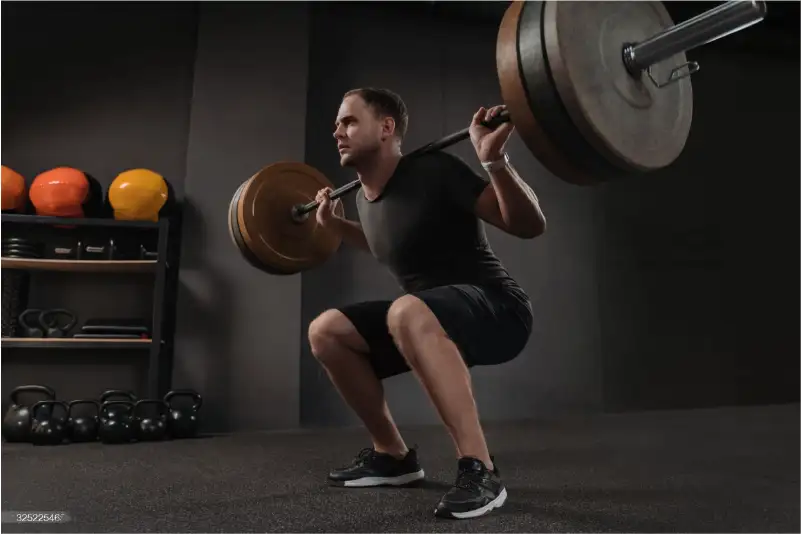

A high bar squat is a back squat where the bar is placed high on the trapezius muscle across the top of the shoulders. The feet are shoulder-width apart with toes pointed slightly outward.
To stay balanced during the squat movement, the bar must stay over the midfoot. When you place the bar high on the back, it demands a more upright torso position and forward movement of the knees to descend properly into a squat position.
What is a Low Bar Squat?
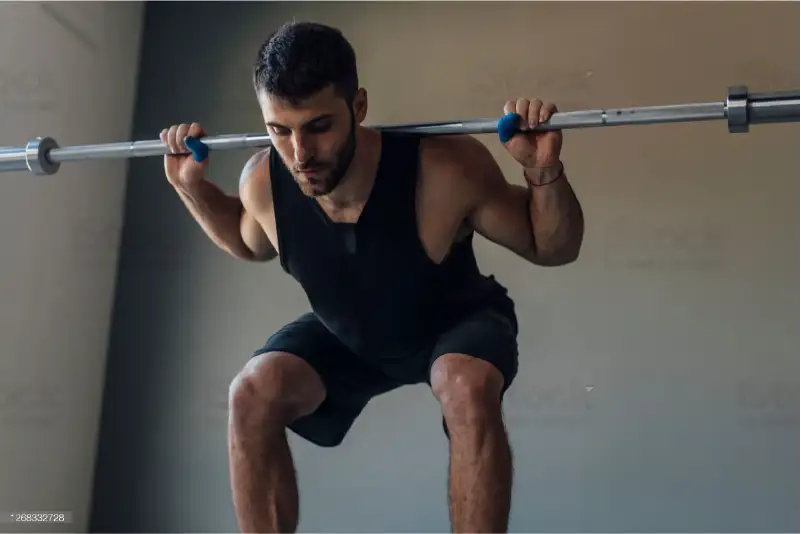

A low bar squat is a squat in which the bar is placed low on the upper back in the back squat position. It should be resting on the posterior deltoid, not the top of the shoulders. The feet are also shoulder-width apart and turned slightly out for this move.
In this squat position, to stay balanced and keep a straight bar path over the midfoot, you must immediately bend slightly at the hips. This causes a more forward lean with the torso during the movement to prevent falling backward.
High Bar form vs Low Bar Squat form Differences
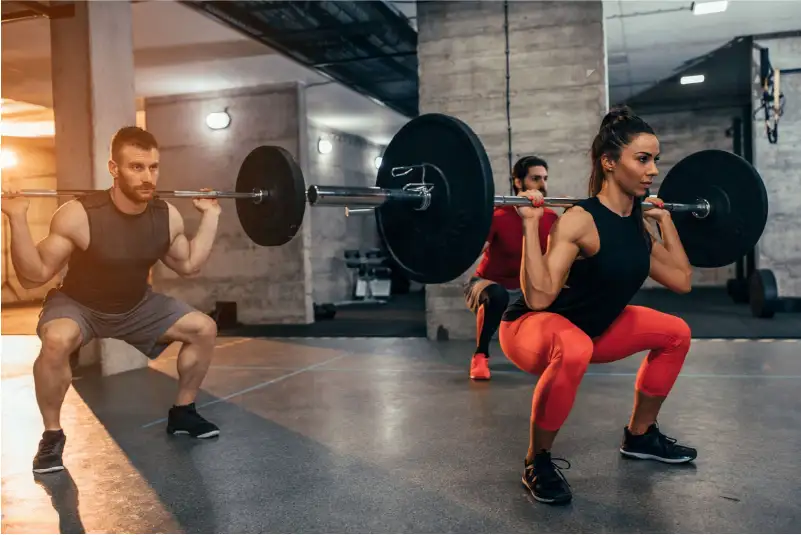

The primary difference between the low-bar and high-bar squat is bar placement on the back. To do the high-bar squat, you’ll lay the barbell on top of the shoulders, just below the C-7 vertebrae. A lot of times, you’ll hear people cue high-bar squat placement by saying, “Use your traps to create a shelf for the bar.”
The low-bar squat places the bar further down on the back across the shoulder blades. A cue often used for low-bar squat placement is, “Lay the bar across the posterior deltoids (backs of shoulders).” In this case, you’ll also be creating a “shelf,” but much lower down. With the low-bar squat, you’ll think about more actively “pinning” the bar to your back rather than having it “sit” there
The difference in bar placement affects other aspects of your squat form as well. Here are some of them:
- Torso angle: The high bar squat form requires a more vertical torso angle than the low bar squat. This is because you need to keep the bar over your center of gravity (midfoot) throughout the movement. If you lean too far forward with a high bar position, you risk losing balance and dropping the bar. The low bar squat allows for more forward lean because the bar is already closer to your center of gravity.
- Hip hinge: The low bar squat form requires more hip hinge than the high bar squat. This means that you need to push your hips back more as you descend into the squat. This helps you maintain a straight bar path and avoid falling backward. The high bar squat requires less hip hinge because you need to keep your knees more in line with your toes.
- Knee travel: The high bar squat requires more knee travel than the low bar squat. This means that your knees need to move further past your ankles to reach proper depth. This puts more stress on your quadriceps and knees but also allows for greater ankle dorsiflexion (bending your ankle upward). The low bar squat requires less knee travel because you need to keep your shins more vertical.
- Depth: The high bar squat allows for greater depth than the low bar squat. This is because you have more mobility in your ankles, knees, and hips with a high bar position. You can also use a narrower stance and point your toes more outward to achieve deeper squats. The low bar squat limits your depth because you have less mobility in your hips and ankles with a low bar position. You also need to use a wider stance and point your toes more forward to prevent your knees from caving in.
High Bar vs Low Bar Squat: Benefits and Drawbacks
Both high bar and low bar squats have their own pros and cons. Here are some of them:
High Bar Squat Benefits
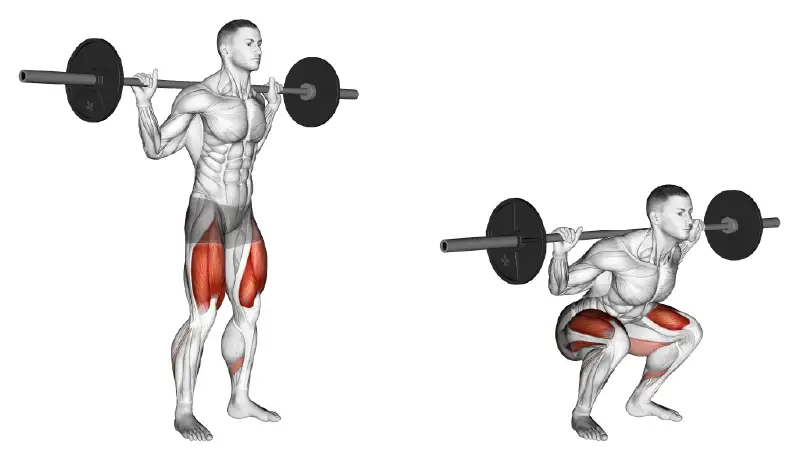

- Quadriceps development: The high bar squat targets the quadriceps more than the low bar squat. This is because the high bar squat requires more knee extension (straightening your leg) than the low bar squat. The quadriceps are the main muscles responsible for knee extension. If you want to build bigger and stronger quads, the high bar squat is a good choice.
- Ankle mobility: The high bar squat improves your ankle mobility more than the low bar squat. This is because the high bar squat requires more ankle dorsiflexion than the low bar squat. Ankle dorsiflexion is the ability to bend your ankle upward. Having good ankle mobility can help you prevent injuries, improve your posture, and perform other exercises better.
- Sport specificity: The high bar squat is more specific to sports that require a lot of jumping, sprinting, and changing directions, such as basketball, soccer, and volleyball. This is because these sports require a lot of quadriceps strength and power, as well as ankle mobility and stability. The high bar squat can help you improve these qualities and transfer them to your sport performance.
High Bar Squat Drawbacks
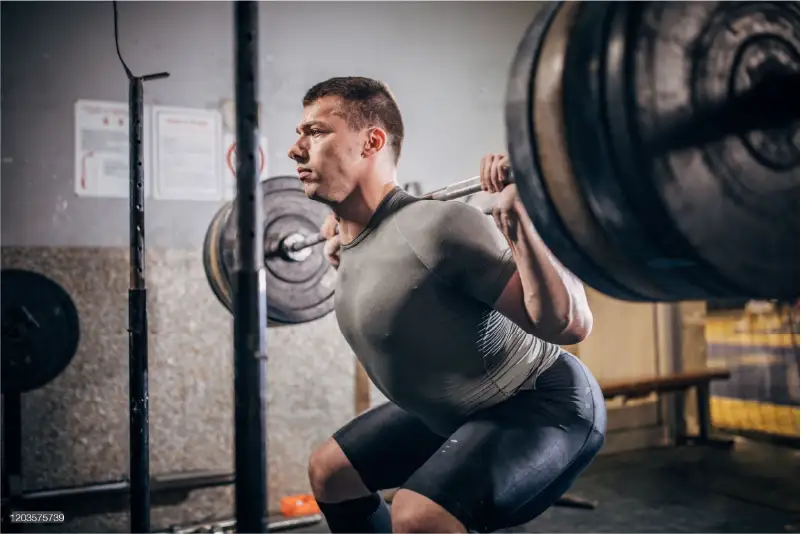

- Lower back stress: The high bar squat puts more stress on your lower back than the low bar squat. This is because the high bar squat requires a more upright torso angle than the low bar squat. This means that your lower back has to work harder to stabilize your spine and prevent it from rounding or arching excessively. If you have lower back issues or poor core strength, the high bar squat may aggravate your condition or cause pain.
- Lower weight: The high bar squat allows you to lift less weight than the low bar squats with weights. This is because the high bar squat relies more on your quadriceps than your posterior chain (glutes, hamstrings, and back extensors). The posterior chain is generally stronger and more powerful than the quadriceps, so it can handle more load. If you want to maximize your strength and muscle mass gains, the high bar squat may not be the best option.
Low Bar Squat Benefits
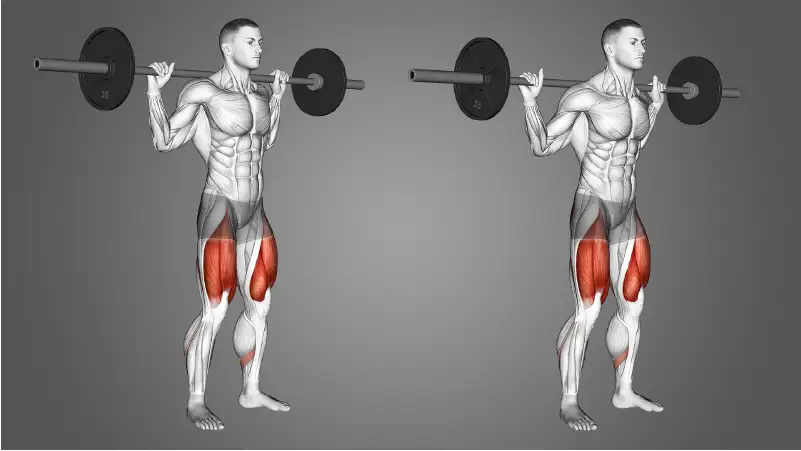

- Posterior chain development: The low bar squat targets the posterior chain more than the high bar squat. This is because the low bar squat requires more hip extension (straightening your hip) than the high bar squat. The posterior chain is the main group of muscles responsible for hip extension. If you want to build bigger and stronger glutes, hamstrings, and back extensors, the low bar squat is a good choice.
- Higher weight: The low bar squat allows you to lift more weight than the high bar squat. This is because the low bar squats with weights uses more of your posterior chain than your quadriceps. The posterior chain is generally stronger and more powerful than the quadriceps, so it can handle more load. If you want to maximize your strength and muscle mass gains, the low bar squat may be the best option.
- Powerlifting specificity: The low bar squat is more specific to powerlifting than other sports. Powerlifting is a sport that consists of three lifts: the squat, the bench press, and the deadlift. The goal is to lift as much weight as possible for one repetition in each lift. The low bar squat can help you increase your total (the sum of your best lifts in each lift) by allowing you to lift more weight in the squat.
Low Bar Squat Drawbacks
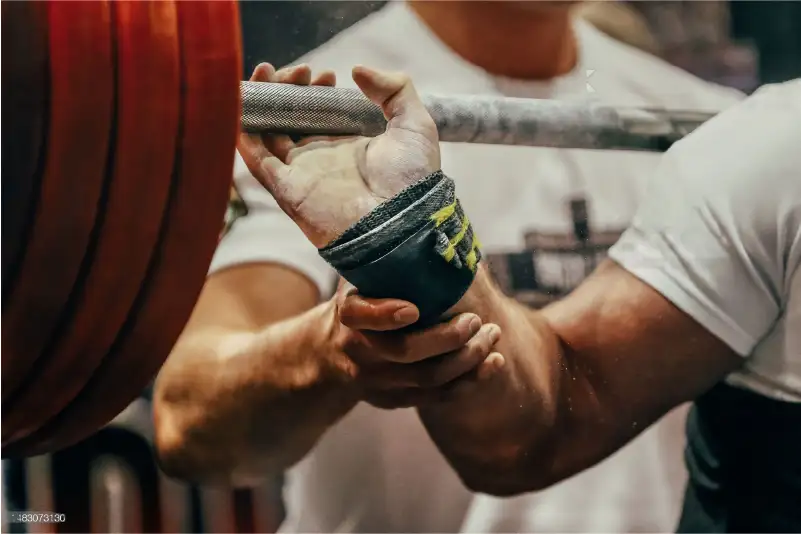

- Shoulder mobility: The low bar squat requires more shoulder mobility than the high bar squat. This is because the low bar squat requires you to place the bar lower on your back and grip it narrower than the high bar squat. This means that you need to have good shoulder external rotation (turning your arm outward) and extension (moving your arm backward) to get into a comfortable and secure position. If you have shoulder issues or poor mobility, the low bar squat may be uncomfortable or painful for you.
- Wrist pain: The low bar squat can cause wrist pain for some people. This is because the low bar squat places a lot of pressure on your wrists as they support the weight of the bar. If you have weak wrists or grip the bar too tightly, you may experience wrist pain or injury during or after the low bar squat.
- Technique difficulty: The low bar squat is more difficult to learn and master than the high bar squat. This is because the low bar squat requires more precision and balance than the high bar squat. You need to find the optimal position for the bar on your back, maintain a straight bar path over your midfoot, keep your torso from leaning too far forward or backward, and avoid letting your knees cave in or flare out too much.
High Bar vs Low Bar Squat: Which One Should You Do?
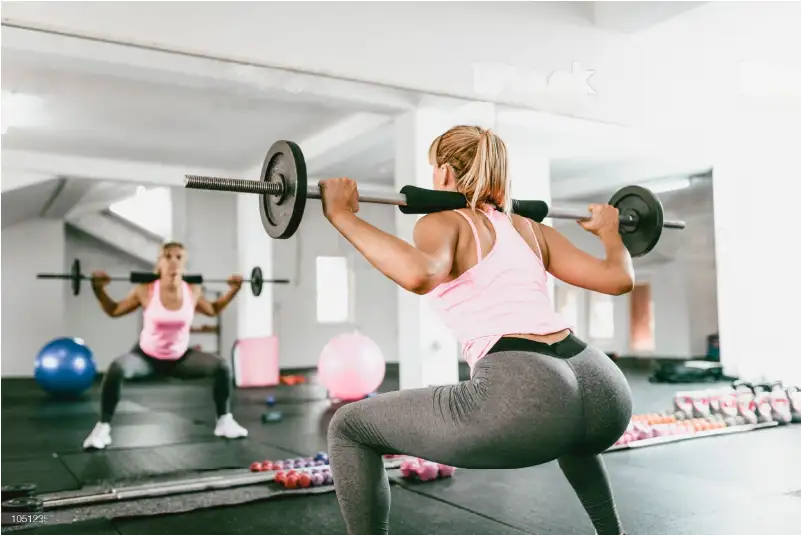

There is no definitive answer to which type of back squat is better or worse for everyone. It depends on several factors, such as:
- Your goals: Do you want to improve your sport performance, increase your strength and muscle mass, or just stay fit and healthy? Depending on your specific goals, you may benefit more from one squat variation than the other. For example, if you are a powerlifter, you may prefer the low bar squat because it allows you to lift more weight and improve your total. If you are a basketball player, you may prefer the high bar squat because it develops your quadriceps and ankle mobility, which are important for jumping and sprinting.
- Your anatomy: Do you have long or short limbs, a long or short torso, or wide or narrow hips? Depending on your body proportions, you may find one squat variation more comfortable and natural than the other. For example, if you have long legs and a short torso, you may find the low bar squat easier to perform because it allows you to lean forward more and reduce the range of motion. If you have short legs and a long torso, you may find the high bar squat easier to perform because it allows you to stay more upright and avoid excessive forward lean.
- Your mobility: Do you have good or poor mobility in your ankles, knees, hips, and shoulders? Depending on your joint mobility, you may be able to achieve proper depth and position with one squat variation more than the other. For example, if you have good ankle mobility, you may be able to do the high bar squat with a narrow stance and deep depth. If you have poor ankle mobility, you may struggle to do the high bar squat without elevating your heels or compromising your form. If you have good shoulder mobility, you may be able to do the low bar squat with a secure grip and stable position. If you have poor shoulder mobility, you may experience pain or discomfort when doing the low bar squat.
- Your preference: Do you enjoy or hate doing one squat variation more than the other? Depending on your personal preference, you may be more motivated and consistent with one squat variation than the other. For example, if you like the feeling of lifting heavy weights and challenging your posterior chain, you may enjoy doing the low bar squat more than the high bar squat. If you like the feeling of working your quadriceps and improving your posture, you may enjoy doing the high bar squat more than the low bar squat.
The best way to determine which squat variation is best for you is to try both of them and see how they feel. You can also use a coach or a trainer to help you assess your form, technique, and performance with each squat variation. You can also use video analysis tools or apps to record yourself doing both squats and compare them side by side.
How to Improve Your Squat Performance
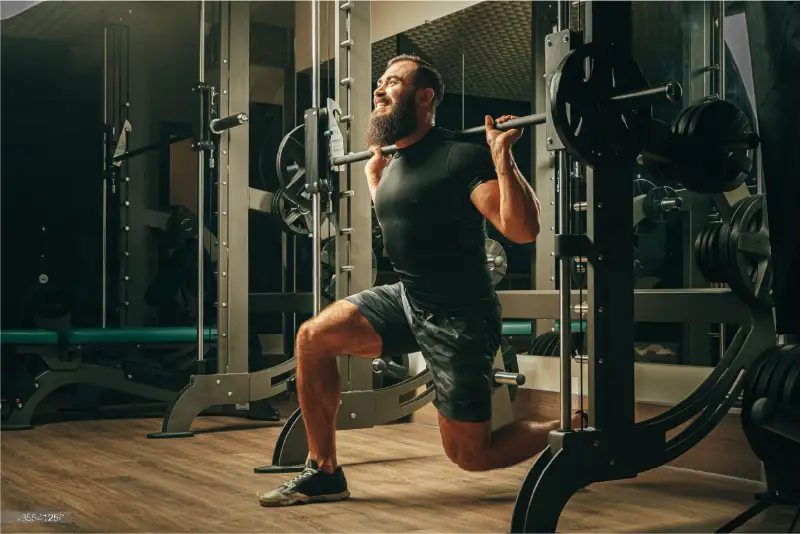

Regardless of which squat variation you choose, there are some general tips that can help you improve your squat performance. Here are some of them:
- Warm up properly: Before doing any squats, make sure to warm up your muscles and joints with some dynamic stretches and mobility exercises. This will help you prevent injuries, increase your range of motion, and prepare your body for the upcoming load. You can also do some light sets of squats with an empty bar or light weight to practice your form and technique.
- Use proper equipment: To do squats safely and effectively, you need to use proper equipment such as a power rack, a barbell, weight plates, collars, and a bench. You can also use additional equipment such as a belt, shoes, knee sleeves, wrist wraps, or chalk to enhance your stability, comfort, and grip. Make sure to adjust the equipment according to your height and preference before doing any squats.
- Follow proper technique: To do squats correctly, you need to follow proper technique throughout the movement. This includes setting up correctly with the bar on your back, bracing your core and breathing deeply before descending into the squat position, keeping your chest up and your eyes forward, pushing your knees out and your hips back, reaching the desired depth, driving up through your heels and squeezing your glutes, and locking out at the top. You can also use cues such as “break at the hips”, “spread the floor”, “big chest”, and “stand tall” to remind yourself of proper technique.
- Progress gradually: To improve your squat performance, you need to progress gradually by increasing the weight, volume, or intensity of your squats over time. This will help you challenge your muscles and stimulate growth and adaptation. However, you need to be careful not to progress too fast or too much, as this can lead to overtraining, injury, or plateau. You can use a program or a calculator to help you determine the optimal progression for your squats based on your goals, experience, and recovery.
- Vary your squats: To avoid boredom, stagnation, or imbalance, you can vary your squats by changing some variables such as the stance width, toe angle, bar position, grip width, tempo, pause, depth, or accessory exercises. This will help you target different muscles and aspects of your squat performance and keep things interesting and fun. However, you need to be careful not to vary too much or too often, as this can interfere with your technique, consistency, or specificity. You can use a cycle or a periodization to help you plan your squat variations based on your goals, needs, and preferences.
Conclusion on high bar vs low bar squat
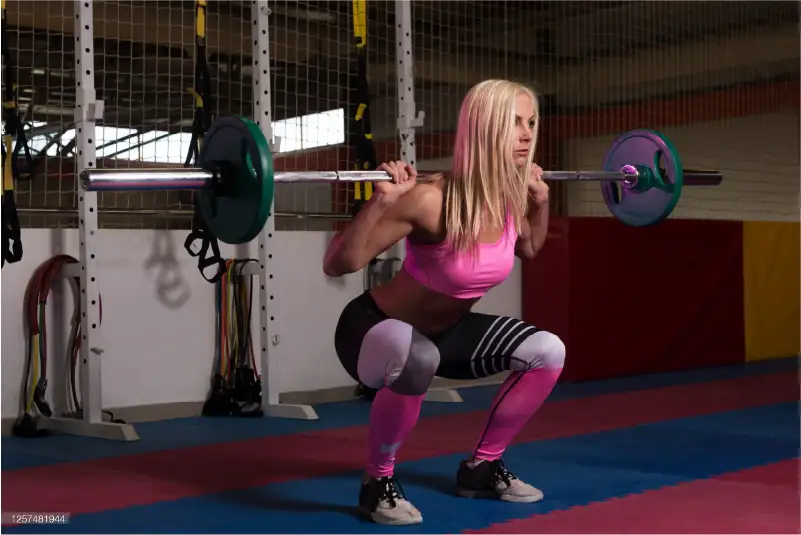

To conclude, the high bar and low bar squat are two different variations of the back squat that have different effects on your muscles, joints, and performance. They also require different techniques, mobility, and equipment to execute properly.
The best way to determine which squat variation is best for you is to try both of them and see how they feel. You can also use a coach or a trainer to help you assess your form, technique, and performance with each squat variation. You can also use video analysis tools or apps to record yourself doing both squats and compare them side by side.
Regardless of which squat variation you choose, there are some general tips that can help you improve your squat performance. These include warming up properly, using proper equipment, following proper technique, progressing gradually, and varying your squats.
We hope this article has helped you understand the difference between the high bar and low bar squat and how to choose the best one for you. If you have any questions or feedback, please let us know. Thank you for reading and happy squatting!
FAQs on high bar vs low bar squat
Here are some frequently asked questions about high bar vs low bar squat:
Which squat is better for beginners?
There is no definitive answer to which squat is better for beginners. It depends on several factors such as their goals, anatomy, mobility, preference, and availability of equipment and coaching. However, some general guidelines are:
- If you have good mobility in your ankles, knees, hips, and shoulders, you may find the high bar squat easier to learn and perform than the low bar squat.
- If you have poor mobility in any of these joints or have shoulder or wrist issues, you may find the low bar squat more comfortable and natural than the high bar squat.
- If you have access to a coach or a trainer who can teach you proper technique and form for both squats, you may benefit from trying both of them and seeing which one suits you better.
- If you don’t have access to a coach or a trainer who can teach you proper technique and form for both squats, you may benefit from sticking to one squat variation that feels good for you and mastering it before trying the other one.
Which squat is better for knee health?
There is no definitive answer to which squat is better for knee health. It depends on several factors such as your technique, load, volume, recovery, and individual differences. However, some general guidelines are:
- If you have healthy knees and follow proper technique and form for both squats, you may not experience any significant difference in knee health between the high bar and low bar squat. Both squats can strengthen your knee joint and surrounding muscles and ligaments, as well as improve your knee stability and mobility.
- If you have knee issues or injuries, you may need to be more careful and cautious with both squats. You may need to reduce the weight, volume, or depth of your squats, or avoid them altogether if they cause pain or discomfort. You may also need to consult a doctor or a physical therapist before doing any squats.
- If you have knee issues or injuries, you may find the low bar squat more suitable than the high bar squat. This is because the low bar squat requires less knee travel and puts less stress on your quadriceps and knees than the high bar squat. However, this also depends on your individual anatomy and mobility. Some people may find the low bar squat more difficult or painful than the high bar squat due to their hip or ankle limitations.
Which squat is better for glute development?
There is no definitive answer to which squat is better for glute development. It depends on several factors such as your technique, load, volume, frequency, and individual differences. However, some general guidelines are:
- If you want to maximize your glute activation and growth, you may benefit from doing both squats and varying them according to your goals and preferences. Both squats can work your glutes, but in different ways and to different degrees.
- If you want to emphasize your glutes more than your quadriceps, you may prefer the low bar squat over the high bar squat. This is because the low bar squat requires more hip extension and puts more stress on your posterior chain than the high bar squat. However, this also depends on your stance width and depth. A wider stance and a deeper depth can increase your glute activation in both squats.
- If you want to isolate your glutes more than your hamstrings and back extensors, you may prefer the high bar squat over the low bar squat. This is because the high bar squat requires more knee extension and puts more stress on your quadriceps than the low bar squat. However, this also depends on your foot placement and angle. A more forward foot placement and a more outward foot angle can increase your glute activation in both squats.
Which squat is better for core strength?
There is no definitive answer to which squat is better for core strength. It depends on several factors such as your technique, load, volume, intensity, and individual differences. However, some general guidelines are:
- If you want to improve your core strength, you may benefit from doing both squats and varying them according to your goals and preferences. Both squats can work your core muscles, but in different ways and to different degrees.
- If you want to challenge your core stability more than your core mobility, you may prefer the high bar squat over the low bar squat. This is because the high bar squat requires a more upright torso angle than the low bar squat. This means that your core has to work harder to stabilize your spine and prevent it from rounding or arching excessively. However, this also depends on your breathing and bracing technique. A proper breathing and bracing technique can increase your core stability in both squats.
- If you want to challenge your core mobility more than your core stability, you may prefer the low bar squat over the high bar squat. This is because the low bar squat requires more forward lean than the high bar squat. This means that your core has to work harder to move your spine and prevent it from collapsing or hyperextending excessively. However, this also depends on your mobility and flexibility in your hips and ankles. A good mobility and flexibility in these joints can increase your core mobility in both squats.
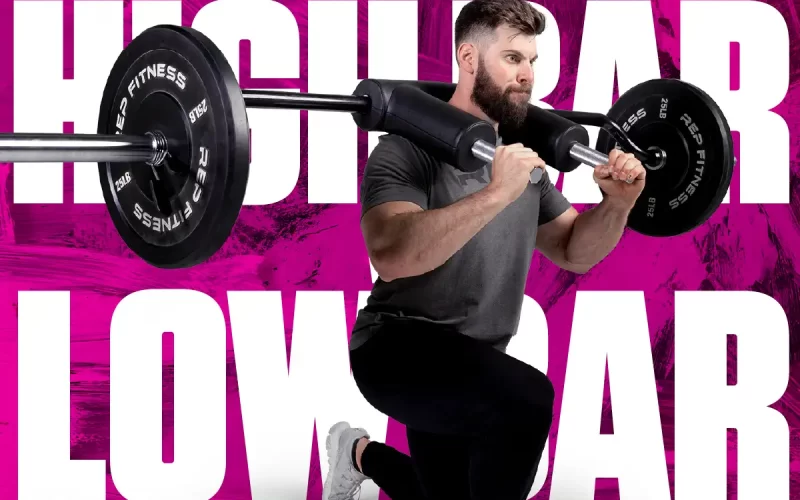




What’s up, I log on to your blogs like every week.
Your writing style is witty, keep doing what you’re doing!